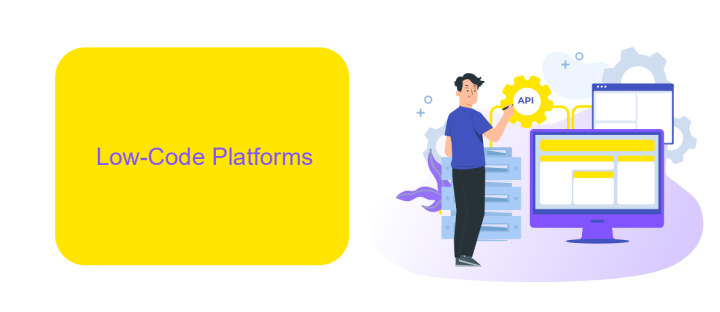Examples of Low-Code No-Code Platforms
In today's fast-paced digital landscape, low-code and no-code platforms are revolutionizing the way businesses develop applications. These platforms empower users with little to no programming experience to create functional and dynamic software solutions. This article explores some of the leading low-code and no-code platforms available, highlighting their features, benefits, and potential use cases for various industries.
Introduction
The rise of low-code and no-code platforms has revolutionized the way businesses approach software development. These platforms enable users with little to no coding experience to create applications, automate workflows, and manage data efficiently. This democratization of technology has empowered non-technical professionals to bring their ideas to life without relying heavily on IT departments.
- Ease of use: Drag-and-drop interfaces make it simple to design applications.
- Speed: Rapid development cycles allow for quicker time-to-market.
- Cost-effective: Reduces the need for expensive development resources.
- Integration: Platforms like ApiX-Drive facilitate seamless integration with various services.
These benefits make low-code and no-code platforms an attractive option for businesses of all sizes. By leveraging tools such as ApiX-Drive, companies can easily connect different applications and automate complex workflows, further enhancing productivity and innovation. As these platforms continue to evolve, their impact on the tech landscape will undoubtedly grow, opening new possibilities for digital transformation.
Low-Code Platforms

Low-code platforms offer a streamlined approach to application development, enabling users to create complex solutions with minimal hand-coding. These platforms provide pre-built templates, drag-and-drop interfaces, and visual modeling tools, which significantly reduce the development time and effort. They are particularly beneficial for businesses looking to accelerate their digital transformation without the need for extensive programming expertise. By leveraging low-code platforms, organizations can empower their non-technical staff to contribute to the development process, fostering greater collaboration and innovation.
One of the key advantages of low-code platforms is their ability to integrate with various third-party services and APIs effortlessly. For instance, ApiX-Drive is a powerful tool that simplifies the integration process, allowing users to connect different applications and automate workflows with ease. This capability ensures that businesses can seamlessly incorporate new functionalities and data sources into their existing systems, enhancing overall efficiency and productivity. By utilizing low-code platforms and integration services like ApiX-Drive, companies can stay agile and responsive to evolving market demands.
No-Code Platforms

No-code platforms empower users to create applications without needing to write any code. These platforms are designed to be user-friendly, allowing individuals with little to no programming experience to develop functional and professional applications. By leveraging visual development tools and pre-built templates, users can quickly bring their ideas to life.
- Bubble: A powerful no-code platform that allows users to design, develop, and host web applications without coding.
- Adalo: Enables the creation of mobile and web applications with a drag-and-drop interface, making app development accessible to everyone.
- ApiX-Drive: A service that simplifies the integration of various applications and services, allowing users to automate workflows without the need for coding.
- Webflow: Combines the power of visual design with the flexibility of code, enabling users to create responsive websites visually.
- Zapier: Connects different apps and automates workflows, making it easier to manage tasks across multiple platforms.
These no-code platforms are transforming the way applications are built, making technology more accessible to a broader audience. By eliminating the need for traditional coding, they enable faster development cycles and encourage innovation. Whether you are a business professional looking to automate tasks or an entrepreneur aiming to launch a new product, no-code platforms offer the tools you need to succeed.
Benefits of Low-Code and No-Code Platforms

Low-code and no-code platforms are revolutionizing the way businesses develop applications by significantly reducing the time and technical expertise required. These platforms enable users to create applications through visual interfaces, eliminating the need for extensive coding knowledge. This democratizes application development, making it accessible to a broader audience.
One of the primary benefits of these platforms is the acceleration of development cycles. Traditional development can take months, but with low-code and no-code solutions, applications can be built and deployed in a matter of days or weeks. This rapid development allows businesses to respond quickly to market changes and customer needs.
- Increased efficiency and productivity
- Cost savings on development and maintenance
- Enhanced collaboration between IT and business teams
- Greater flexibility and scalability
Moreover, these platforms often come with built-in integration capabilities. For instance, services like ApiX-Drive enable seamless integration between various applications and systems, further enhancing the functionality of low-code and no-code solutions. This allows businesses to automate workflows and improve overall operational efficiency.
- Automate the work of an online store or landing
- Empower through integration
- Don't spend money on programmers and integrators
- Save time by automating routine tasks
Examples of Low-Code and No-Code Platforms
Low-code and no-code platforms have revolutionized the way businesses approach software development, enabling even non-technical users to create applications with ease. One prominent example of a low-code platform is Microsoft Power Apps, which allows users to build custom apps with minimal coding. Another notable platform is OutSystems, known for its robust features and scalability, making it a preferred choice for enterprises looking to accelerate their development processes.
No-code platforms are equally transformative, with tools like Bubble empowering users to create fully functional web applications without writing a single line of code. Similarly, Airtable combines the simplicity of a spreadsheet with the power of a database, enabling users to manage and automate workflows effortlessly. For those looking to integrate various services seamlessly, ApiX-Drive offers a no-code solution to connect different applications, ensuring smooth data flow and automation across platforms.
FAQ
What is a Low-Code No-Code platform?
Who can benefit from using Low-Code No-Code platforms?
Can Low-Code No-Code platforms be used for complex applications?
How do Low-Code No-Code platforms handle integrations and automation?
Are Low-Code No-Code platforms secure?
Apix-Drive is a simple and efficient system connector that will help you automate routine tasks and optimize business processes. You can save time and money, direct these resources to more important purposes. Test ApiX-Drive and make sure that this tool will relieve your employees and after 5 minutes of settings your business will start working faster.


